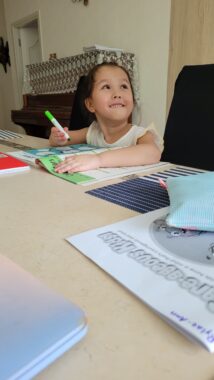How positive intervention helps curb our daughter’s bad behavior
When it comes to behavioral issues, prevention is key, a columnist says
Written by |

My daughter, Rylae-Ann, chucked her cup and its contents of sweet juice across the room. As the plastic cup bounced to a standstill, it took every ounce of patience not to respond with anger, but rather thoughtful, positive language.

Rylae-Ann Poulin, 5, practices properly holding a cup and drinking from it during a drama session with her parents. (Photo by Richard E. Poulin III)
Rylae-Ann is 5 years old and suffers from a rare disease called aromatic l-amino acid decarboxylase (AADC) deficiency. Fortunately, she received gene therapy when she was 18 months old. She has made significant progress, but the developmental delays have caused issues that test our patience.
Maybe it’s a result of AADC deficiency, maybe it’s a developmental process she is going through, or it could be a combination of both. What my wife, Judy, and I do know is that Rylae-Ann is still very anxious and has impulsive outbursts. Judy is a special education teacher, and she deals with similar issues among students who have attention-deficit/hyperactivity disorder.
Judy applied strategies she used for special needs cases. Rylae-Ann has made improvements with her anxiety through drama therapy, and her behavior has improved with music therapy. But the small, incremental progress spans months. While she progresses, it is essential to maintain patience and respond in a supportive manner. If not, the progress could be slower or she could even regress.
Positive behavioral interventions and supports
As educators, Judy and I took several courses on positive behavioral interventions and supports (PBIS) training. PBIS provides teachers with a framework for managing student behavior and supporting students in making improvements. We never thought our training would be as essential as it has been.
PBIS is a proactive approach instead of responding only when a child does something wrong. The goal is to reinforce positive behaviors rather than trying to condition kids through punishment. The approach is best accomplished collaboratively, consistently, and throughout the day. PBIS has demonstrated improved academic outcomes and social-emotional development for all students in schools.

Rylae-Ann Poulin finishes a tantrum after an exhausting day. (Photo by Richard E. Poulin III)
What is positive language?
Positive language is an approach that considers how children will perceive our words and structures responses so they are received as motivation instead of punishment. It also models the language we want children to use.
If we respond with negative language, we decrease our daughter’s self-esteem. For example, if she throws the cup and we say anything like “Bad girl! What are you doing? Why did you do that?” it directs negativity toward her instead of her actions. This negative talk, combined with Rylae-Ann’s anxiety, made her impulsive behavior even worse.
If we yell or respond with physical force, we teach our daughter to do the same. It’s easier said than done, and I must admit there are times when I cannot control my own impulsive behavior and catch myself yelling. Thankfully, Judy and I work as a team and step in to be that cool, calm voice as needed.

Traditional schoolwork used to be an instant trigger for poor behavior, but over time Rylae-Ann Poulin has learned positive behavior and better control. (Photo by Richard E. Poulin III)
When Rylae-Ann throws the cup, we try not to react. The extra attention could promote similar actions in the future. Instead, we respond with something like “Excuse me, I don’t like when you throw your things. It makes me feel sad when you waste your juice. Who will help clean up this mess?” or “Rylae-Ann, we do not throw our food. If you feel angry, you should count to three.” We have different responses for different situations and tailor our words based on her understanding.
Role modeling the behavior and language we want
The best way to start is to consider how you want your child to respond and the words you want them to use. With Rylae-Ann’s limited speech, it’s even more important to use the right words. She’s learning from us with each word we use, so we also think of PBIS as a form of speech therapy.
We teach Rylae-Ann expected behaviors through explicit instruction. We provide her opportunities to practice positive behavior and give positive feedback to motivate her. Research has shown that PBIS is an effective strategy for managing behavior, and it has worked for our daughter. Stepping in early can prevent more severe behavioral problems later and increase positive memories along your journey.
Note: AADC News is strictly a news and information website about the disease. It does not provide medical advice, diagnosis, or treatment. This content is not intended to be a substitute for professional medical advice, diagnosis, or treatment. Always seek the advice of your physician or other qualified health provider with any questions you may have regarding a medical condition. Never disregard professional medical advice or delay in seeking it because of something you have read on this website. The opinions expressed in this column are not those of AADC News or its parent company, Bionews, and are intended to spark discussion about issues pertaining to aromatic l-amino acid decarboxylase deficiency.





Leave a comment
Fill in the required fields to post. Your email address will not be published.